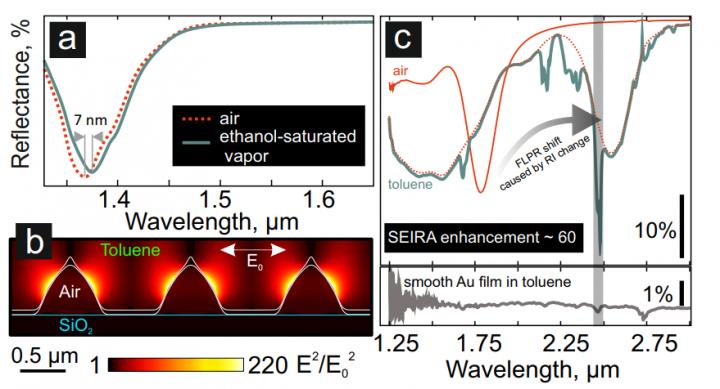
Credit: FEFU press office
Scientists of Far Eastern Federal University (FEFU) with colleagues from Russia, Japan, and Australia have developed a multi-purpose sensor based on a specially designed gold film which surface contains millions of parabolic nanoantennas produced by femtosecond laser printing. The sensor identifies molecules at trace concentration detecting them in liquid and gas environments. It can be easily adjusted to provide different modalities including biological studies, medical and security tasks. The related research is published in Nanomaterials.
The sensor reacts on the tiniest changes of the surroundings in the close proximity to its surface, e.g. gas or organic molecules, changes in the local refractive index of a liquid, etc. and can be applied for bioanalysis, environmental monitoring, food quality analysis, and various security systems.
‘Despite the significant progress that science has made in the field of high-precision physicochemical sensors over the past several decades, flexible inxpensive technologies for manufacturing cheap multi-purpose sensors combining different measurement modalities within single device are still required. Existing lithographic technologies for such sensors fabrication are time and money consuming and therefore are not suitable for mass production. We proposed efficient and cheap laser printing technology to solve the mentioned issue. Using it we can easily produce sensor elements with the desired surface morphology and resonant properties, optimized to merge different sensing modalities and, to have sufficient mechanical strength to operate in liquid environment’ said Aleksandr Kuchmizhak, research fellow at the FEFU STI for Virtual and Augmented Reality.
The sensor system based on nanotextured gold film was fabricated by direct femtosecond-laser printing. The exposure of such an ultrathin gold film to single femtosecond pulses resulted in formation of millions of hollow parabolic nanostructures (nanovoids), the so-called nanoantennas. An ordered array of these nanostructures has pronounced resonant optical properties. They effectively convert incident radiation of the visible and IR spectral ranges into special surface waves, so-called surface plasmons, which provide the sensor with its remarkable sensitivity to changes of the surroundings.
Scientists from FEFU, FEB RAS and MEPhI, as well as from Nagoya Institute of Technology (Japan), Tokai University (Japan) and Swinburne University of Technology (Australia) took part in the work.
Previously, scientists from FEFU and Swinburne University of Technology teamed up with Indian and Japanese colleagues had developed an optical element based on an array of cross-shaped silicon nanoantennas. Being arrange in an appropriate way, these nanoantennas formed a spiral waveplate for middle-IR and THz spectral ranges allowing to convert an ordinary Gaussian beam to a singular vortex beam. The optical element aimed to conduct advanced laboratory studies of the proteins’ structure in IR spectral range, as well as to study new chiral molecular compounds.
###
This work was supported by Russian Science Foundation through the grant No. 16-12-10165.
Media Contact
Alexander Zverev
[email protected]
Related Journal Article
http://dx.




